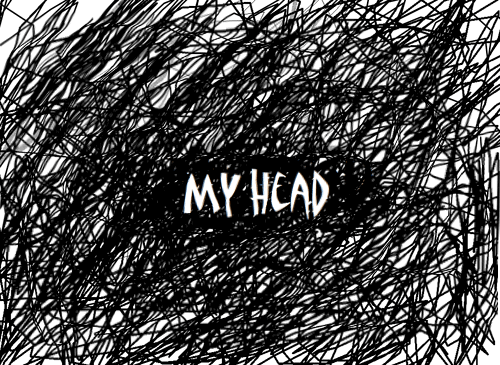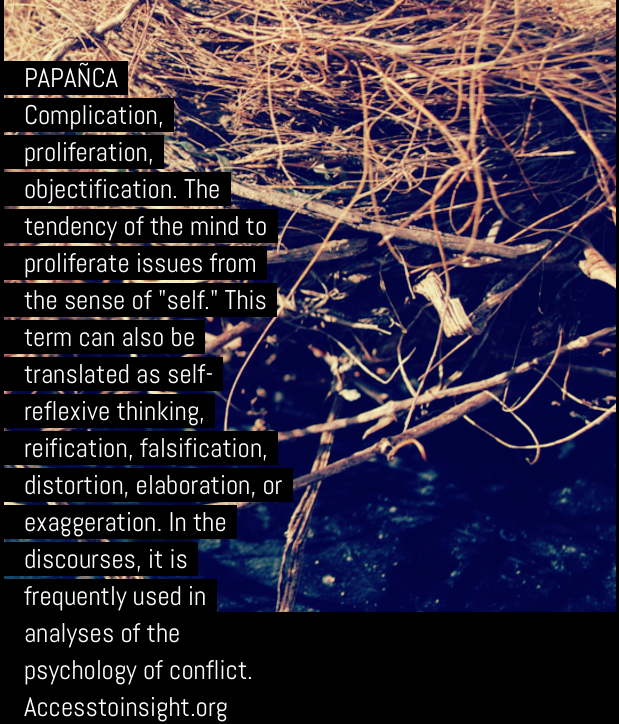So, my head has not been like this at the start of this semester,

The mess in this animated gif, showing that ‘pesky habit mind’ is called, in Buddhism, papañca (pali and pronounced papancha); a term I have come to love because it describes mental proliferations in such an onomatopoeic way. Let me start with a definition and then tell you what this has to do with initial reflections at the start of this semester.
This semester I challenged myself to work with what emerges a little more, rather than try to make it fit a fixed notion of what ‘should’ emerge. I am applying this in-life practice to something that has caused a great deal of noise in this head in past semesters: Technology Dukkha.
As ‘somebody’ who has benefitted from using the web for learning and having a technology background, I hold views about what best practice would be for the topic I am teaching; and nowhere in those views is Blackboard seen as desirable. I have spent many an hour exercising ill will and restlessness as Blackboard could never deliver the environment I wanted for students; encouraged by other educators who I talk to on the social web who also have preferences for tools other than Blackboard. I could go on, and I have gone on and on and on…both in my head and to anyone else who would listen.
This semester I got tired of the noise in my head.
I wondered, what if I practiced what I preach a little more and choose a new pattern? What might it be? This semester I could simply follow the rules. This habit mind is quite unfamiliar with this particular behaviour. Could it have the ability develop this new ‘habit’? Would this even be a more skilful habit? A life spent challenging givens is challenged by the idea of ‘Just follow the rules’! I ask students to experiment, so I experiment too.
I have a dialogue partner and I took this to our inquiry: What stops us trusting emergence a little more to help us reduce papañca? We move an experiment that starts in the personal realm, to the contemplative realm in an inquiry setting. What can this new practice teach us about the spiritual life?
We discovered that the need to break the rules and set ourselves apart as doing it ‘better than them’ fulfilled and important function in propping up the idea of a ‘self’. For as long as I was running around frustrated that I could not teach in WordPress, focused on all that Blackboard could not do for students, I reinforced the idea that ‘I’ was ‘better than’ [fill in the blank]; hence papañca ensued and this mind was kept busy propping up yet another sankhara. It was exhausting.
We are only at the start of the semester but the experiment is already bearing fruit. I was surprised when at the start of the semester I felt calm and ready to focus on what I am there to do: Teach. I said to a colleague: ‘All I am going to do this year is teach’. What this meant to me was: I would take the tools I am given and use them to do what I know how to do, support people in finding their love for learning; the tool does not do that, it is our presence as educators deeply listening and ‘seeing’ another that does that, in Blackboard or elsewhere.
I can only say: there is so much more room to teach, from a place that is new to this mind: Acceptance of what is and greater discernment of what matters to learning.
As I started to write this post I wanted to find a definition of papañca that could be understood by those not familiar with Pali. The visual above was my best attempt. I then wondered if we might find a passage from Buddhist scripture, as this is the basis of the approach to Dialogue I teach, that we could use as contemplation this semester. Of course, there are wonderful suttas we could read. Yet, I was struck by a translator’s note as maybe being more supportive of where students are in their path. This is Thanissaro Bhikkhu in 1999:
“The root of […] papañca is the perception, “I am the thinker.”
From this self-reflexive thought — in which one conceives a “self,” a thing corresponding to the concept of “I” — a number of categories can be derived:
- being/not-being,
- me/not-me,
- mine/not-mine,
- doer/done-to,
- signifier/signified.
When there’s the sense of identification with something that experiences, then based on the feelings arising from sensory contact, some feelings will seem appealing — worth getting for the self — and others will seem unappealing — worth pushing away. From this there grows desire, which comes into conflict with the desires of others who are also engaging in papañca. This is how inner objectifications breed external contention.”
A point here is we all do this. It is the nature of the human condition and setting ourselves up to not do it anymore [ever], mostly adds to the reification of the ‘I’ thought. This takes years of practice to gain some insight into.
What struck me about this passage was how similar it was to something else we are reading. We started David Bohm ‘On dialogue’, as this is the other thread of context that the approach I teach is based on. As I reviewed the pages I assigned to students yesterday, I read:
“If you watch, you’ll see an intention to think, an impulse to think. Then comes the thought, and the thought may give rise to a feeling, which might give rise to another intention to think, and so on. You’re not aware of that, so the thought appears as if it were coming by itself, and the feeling appears to be coming by itself, and so on.”
One quote from Buddhism, another from physics. Yet, I see both quotes as describing the same phenomenon. Bohm further expands on the idea that ‘thought produces results and then says it did not do it’. In the same way we may say once we conceive of a ‘self’ as a stable entity then thought ‘belongs’ to that ‘self’.
In buddhism we work to gain insight into the 3 characteristics to tackle papañca. This takes many lifetimes. Yet, I found a passage in Bohm yesterday that I thought explained a process that would allow anyone to gain awareness of papañca; a process that is maybe more standalone than the concept of Insight in Theravada Buddhism – Bohm’s concept of suspending thought:
“What is called for is to suspend those assumptions, so that you neither carry them out nor suppress them. You don’t believe them, nor do you disbelieve them; you don’t judge them as good or bad. Normally when you are angry you start to react outwardly, and you may just say something nasty. Now suppose I try to suspend that reaction. Not only will I now not insult that person outwardly, but I will suspend the insult that I make insideof me. Even if I don’t insult somebody outwardly, I am insulting him inside. So I will suspend that, too. I hold it back, I reflect it back. You may also think of it as suspended in front of you so that you can look at it—sort of reflected back as if you were in front of a mirror. In this way I can see things that I wouldn’t have seen if I had simply carried out that anger, or if I had suppressed it and said, “I’m not angry” or “I shouldn’t be angry.””
Suspending our thought process can help us see beyond the ‘I’ thought, may helps us over time do what Bohm describes as dialoguing ‘behind’ individual assumptions, where we find the tacit space that belongs to participative thought.
A point to take into further contemplation.
In the meantime, I would never have had time to craft this post had I been lost in a battle for ‘why not WordPress?!’ with my university.
May we all find ways to that tacit space that enables us to discern what communication needs beyond individual thought.
Pali words used in the text (definitions from Access on Insight’s Glossary):
Saṅkhāra: Formation, compound, fashioning, fabrication — the forces and factors that fashion things (physical or mental), the process of fashioning, and the fashioned things that result. Saṅkhāra can refer to anything formed or fashioned by conditions, or, more specifically, (as one of the five khandhas) thought-formations within the mind.
Dukkha: Stress; suffering; pain; distress; discontent.

In the past I’ve heard papanca described as the proliferation of the story, the way the mind goes down the rabbit hole. In your piece, I really saw the act of papanca as the root of “becoming,” the moment where a self is created and re-created.
Such a subtle and important moment to bring to awareness.
Thank you for that!
Celia